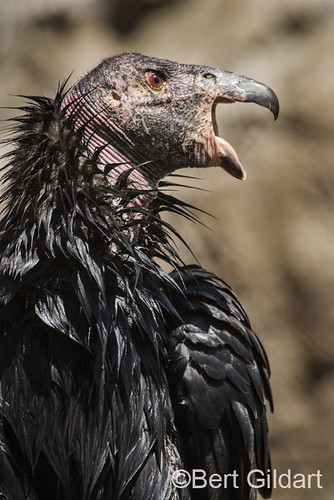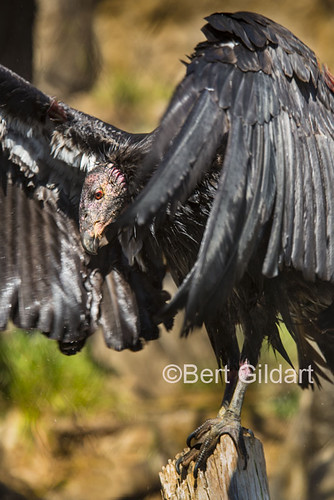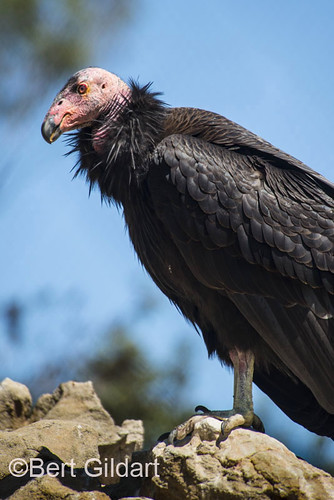California Condor Milestone
©Bert Gildart: April 8th, 2013 – this past Tuesday – marked a milestone in the history of both the California Condor and in the role the San Diego Zoo.
Thirty years ago four California condors hatched in the zoo and soon came to form the foundation of a breeding program. The fate of one of the condors remains a mystery, but officials named the other three Sespe, Sisquoc and Almiyi. However, Sespe is still exhibited at the San Diego Safari Park, which is located in Escondido. This facility is huge and is an affiliate of the San Diego Zoo. In addition to exhibiting a variety of animals in realistic habitats, Safari Park conducts much research and engages in various experimental programs to include a condor breeding program. The park is joined in their condor research efforts by several other wildlife centers, to include the U.S. Fish & Wildlife Service.
Though I have no way of knowing which of the several condors I photographed this past week, I have to assume that one of the birds might have been a descendent of this original group. The bird shown here appears to be relatively young, but it really makes no difference to me which I photographed, for all are magnificent – and their presence represents the best of qualities in humans. Just a few years ago, the species was extinct from the wild. Apparently not a single bird remained from a land in which it had once been prominent.
L to R: Immature California Condor; condors have a wing span that approaches 10 feet, largest of any North American
birds; mature — or breeding — plumage of adult condor, showing light red head.
Still, the California Condor remains one of the world’s rarest bird species. In May 2012 population counts put the number of known condors at 405, including 226 living in the wild and 179 in captivity. The successful reintroduction derives from the cooperative – and successful – work of four wildlife organizations working together, which is the reason we are now seeing the magnificent California Condor in the Grand Canyon and Zion national parks.
CONDOR CHARACTERISTICS
As you can see Condors are quite large, and at well over nine feet, the species has the greatest wingspan of any North American bird. Typically, the head of young birds is grey while that of older breeding birds range from yellow to bright orange. Several other birds were displayed at Safari Park and one of them had a head that was colored a bright orange.
DIFFICULT TO PHOTOGRAPH
Though the Safari Park provides a huge enclosure for their condors, they are confined by a mesh cage which makes photography difficult. The secret is to use a telephoto lens and then open it to the widest f-stop your camera will allow. You must then position yourself so the eyes of the bird are not covered by the mesh, then selectively focus on the bird’s eyes. Everything else will most likely have a soft focus appearance, but no matter. Just so long as the eyes of the bird are clear there will be no clue that the bird is caged – and not wild and free.
Condors are long lived and may reach the age of 60, but because of the history of successful reintroduction, this birthday was special. In commemoration of the bird’s birthdays a local newspaper reported that handlers at Safari Park filled a cardboard box with treats for the birds to tear open and enjoy. Tidbits included mice, rats, meatballs and beef spleen. Kudos should also go to the dedicated wildlife managers for without them, the world would now be bereft of this magnificent bird.
———————————————-
THIS TIME LAST YEAR:
———————————————-
BOOKS FOR SALE:
4th ed. Autographed by the Authors
Hiking Shenandoah National Park
 Hiking Shenandoah National Park is the 4th edition of a favorite guide book, created by Bert & Janie, a professional husband-wife journalism team. Lots of updates including more waterfall trails, updated descriptions of confusing trail junctions, and new color photographs. New text describes more of the park’s compelling natural history. Often the descriptions are personal as the Gildarts have hiked virtually every single park trail, sometimes repeatedly.
Hiking Shenandoah National Park is the 4th edition of a favorite guide book, created by Bert & Janie, a professional husband-wife journalism team. Lots of updates including more waterfall trails, updated descriptions of confusing trail junctions, and new color photographs. New text describes more of the park’s compelling natural history. Often the descriptions are personal as the Gildarts have hiked virtually every single park trail, sometimes repeatedly.
Big Sky Country is beautiful
Montana Icons: 50 Classic Symbols of the Treasure State
![]() Montana Icons is a book for lovers of the western vista. Features photographs of fifty famous landmarks from what many call the “Last Best Place.” The book will make you feel homesick for Montana even if you already live here. Bert Gildart’s varied careers in Montana (Bus driver on an Indian reservation, a teacher, backcountry ranger, as well as a newspaper reporter, and photographer) have given him a special view of Montana, which he shares in this book. Share the view; click here.
Montana Icons is a book for lovers of the western vista. Features photographs of fifty famous landmarks from what many call the “Last Best Place.” The book will make you feel homesick for Montana even if you already live here. Bert Gildart’s varied careers in Montana (Bus driver on an Indian reservation, a teacher, backcountry ranger, as well as a newspaper reporter, and photographer) have given him a special view of Montana, which he shares in this book. Share the view; click here.
$16.95 + Autographed Copy
What makes Glacier, Glacier?
Glacier Icons: 50 Classic Views of the Crown of the Continent
![]() Glacier Icons: What makes Glacier Park so special? In this book you can discover the story behind fifty of this park’s most amazing features. With this entertaining collection of photos, anecdotes and little known facts, Bert Gildart will be your backcountry guide. A former Glacier backcountry ranger turned writer/photographer, his hundreds of stories and images have appeared in literally dozens of periodicals including Time/Life, Smithsonian, and Field & Stream. Take a look at Glacier Icons
Glacier Icons: What makes Glacier Park so special? In this book you can discover the story behind fifty of this park’s most amazing features. With this entertaining collection of photos, anecdotes and little known facts, Bert Gildart will be your backcountry guide. A former Glacier backcountry ranger turned writer/photographer, his hundreds of stories and images have appeared in literally dozens of periodicals including Time/Life, Smithsonian, and Field & Stream. Take a look at Glacier Icons
$16.95 + Autographed Copy





April 19th, 2013 at 3:57 pm
[...] Janie and Larry rested after we got off the tram at Nairobi Station, while Bert and I hoofed it up to Condor Ridge. Photographing the California Condor through a mesh enclosure is difficult, but Bert reveals how it’s done in his post, “California Condor Milestone“. [...]
April 19th, 2013 at 4:36 pm
Thanks for your wonderful photos of the California condor and tips on how to photograph them through their mesh enclosures.
See additional photos of our visit to the San Diego Zoo Safari Park:
http://airstreamlife.com/historysafariexpress/2013/04/19/san-diego-safari-interlude/